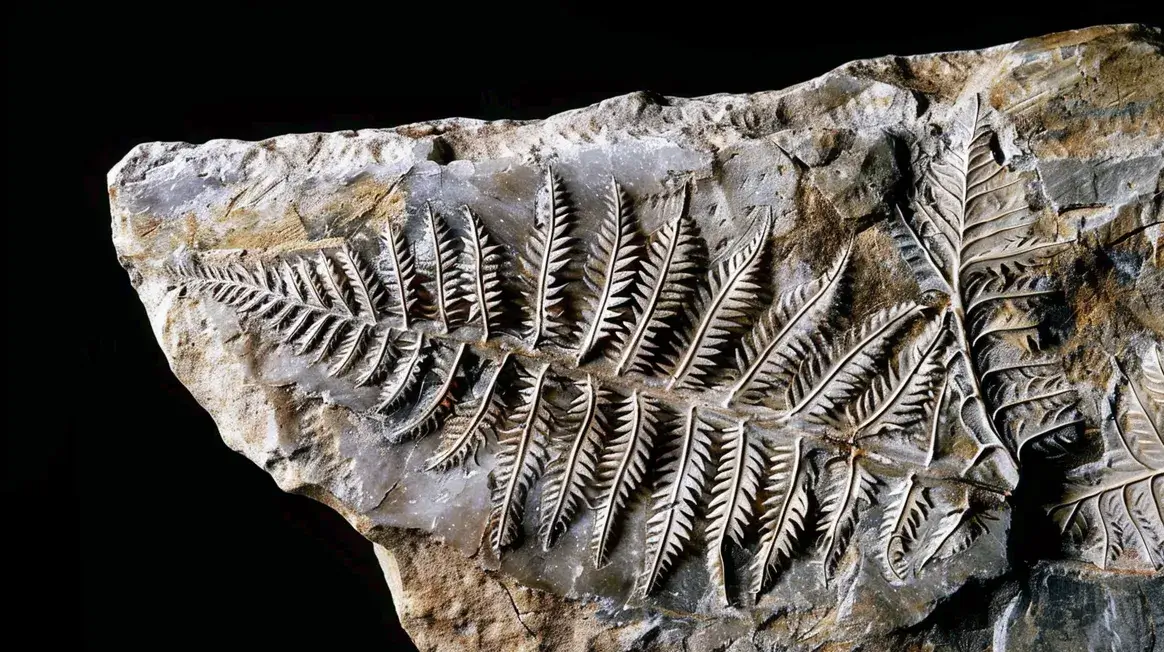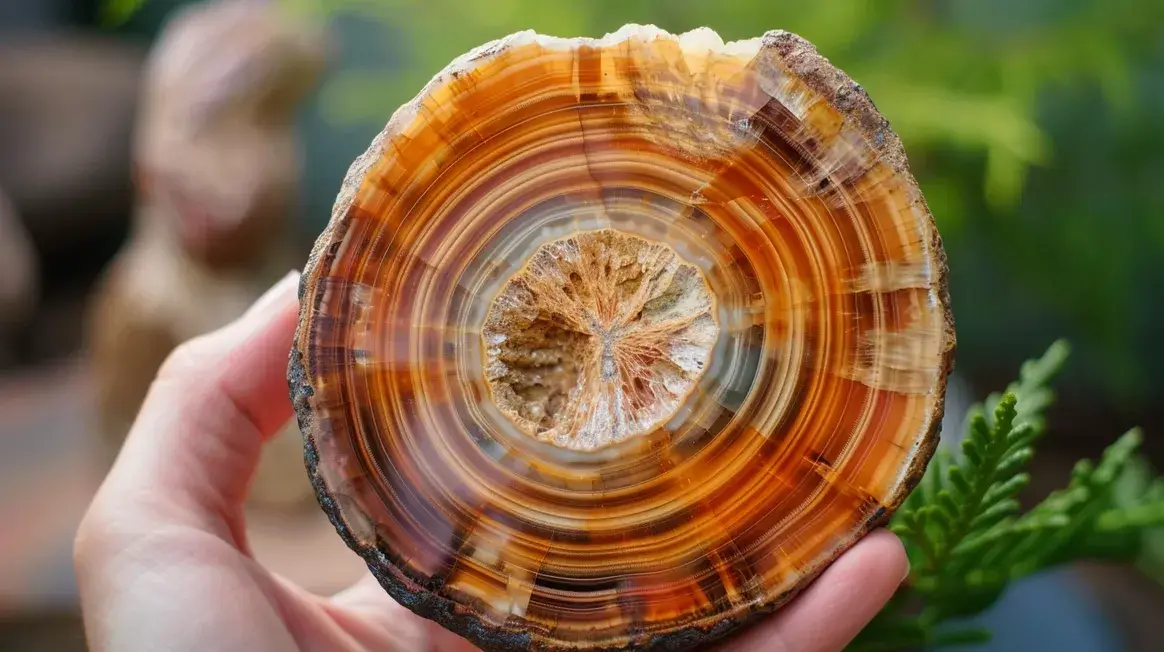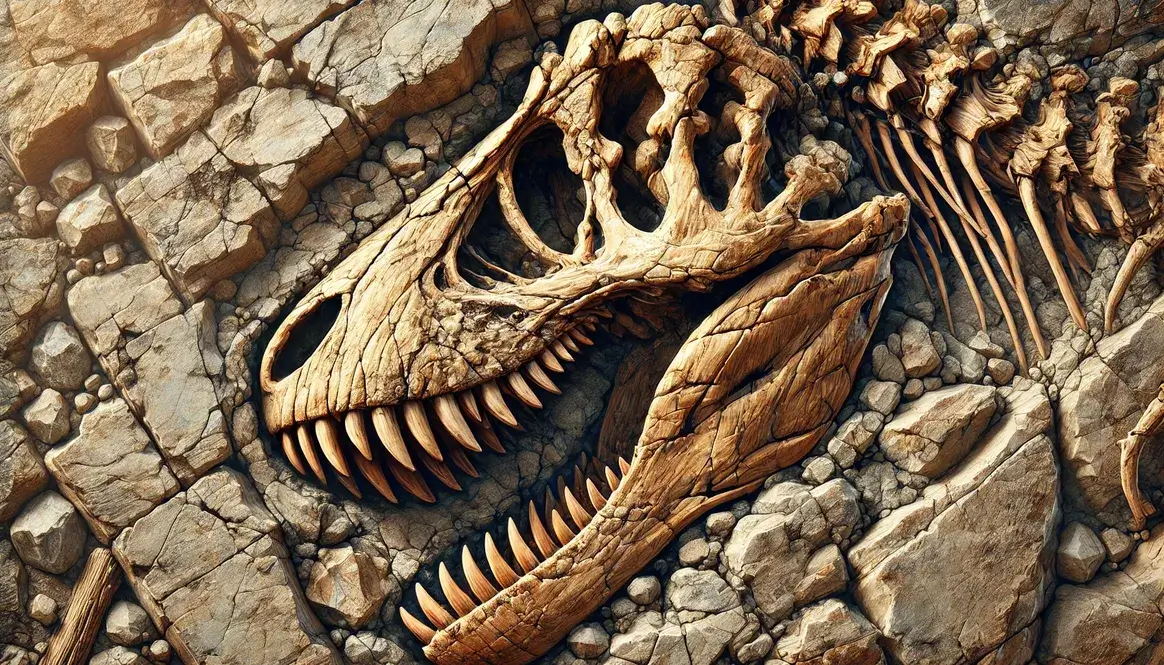Carbon fossils stand as some of the most detailed records of prehistoric life on Earth. These special fossils form when plants and animals leave behind dark, paper-thin impressions in rock, preserving exact details of their bodies from millions of years ago.
| Key Facts About Carbon Fossils | What They Tell Us |
|---|---|
| Preservation Type | Thin films of carbon showing detailed impressions |
| Best Preserved Specimens | Leaves, insects, fish, small animals |
| Age Range | 20 million to 500+ million years old |
| Scientific Value | Shows fine details of soft tissues and structures |
| Main Locations | Coal deposits, fine-grained sedimentary rocks |
What Are Carbon Fossils?
Carbon fossils occur when dead plants or animals get squashed between layers of soft mud or sediment, creating a paper-thin dark film that shows the exact shape of the original organism. These fossils work like a natural photo negative, capturing tiny details that other types of fossils can’t preserve.
Unlike regular fossils that turn to stone, carbon fossils stay soft and flexible. They form a thin sheet that scientists can sometimes peel away from the rock, similar to lifting a sticker. This unique preservation method makes carbon fossils different from body fossils, which are made of hard materials like bone and shell.
These fossils often preserve parts that usually rot away. Small creatures, plant leaves, and even fish scales show up in perfect detail, complete with patterns that tell scientists about how these ancient organisms looked and lived. The carbon material comes from the original organic matter of the plant or animal, making these fossils direct evidence of prehistoric life.
Here’s what different organisms typically leave behind in carbon fossils:
| Organism Type | Preserved Features |
|---|---|
| Plants | Leaf veins, stem patterns, seed structures |
| Insects | Wing patterns, leg segments, antennae |
| Fish | Scales, fins, internal organs |
| Small Animals | Skin impressions, fur patterns, soft tissues |
Carbon fossils help scientists piece together what life looked like millions of years ago. They’re especially good at showing what ancient plants looked like and how small animals moved and lived. When scientists study these fossils, they can learn about extinct species and how they fit into prehistoric ecosystems.
The Process of Carbon Fossil Creation
Before a carbon fossil can form, specific conditions must exist. Most plants and animals decay after death, but sometimes nature preserves them through a special process that turns them into carbon fossils.
Stage 1: Death and Quick Burial
For a carbon fossil to form, the first moments after death matter most. The process starts when a plant or animal dies in or near water. Three main factors determine if the remains will become a carbon fossil:
| Required Condition | Why It Matters |
|---|---|
| Quick Burial | Protects remains from scavengers and decay |
| Low Oxygen | Stops bacteria from breaking down tissues |
| Fine Sediment | Creates clear impressions of the specimen |
Speed plays a key role in this process. Most carbon fossils form in lakes or lagoons where fine mud quickly covers dead organisms. This mud acts like a protective blanket, keeping out destructive forces that would normally cause decay.
These places work perfectly because:
- Calm water allows sediment to settle gently
- Mud particles are tiny enough to capture fine details
- Deep water contains less oxygen
- Few scavengers live in these environments
The bottom of these ancient water bodies created perfect conditions for preservation. When plants or small animals sank to the bottom, they entered a world without oxygen. The lack of oxygen meant bacteria couldn’t break down the remains as they usually would.
This combination – quick burial in fine mud and no oxygen – starts the path toward creating a carbon fossil. The next stages of the process happen over thousands or millions of years as more layers of sediment pile on top.
Stage 2: Carbon Layer Formation
Once burial happens, chemical changes begin transforming the remains. This stage focuses on how the original tissues break down and leave behind a thin sheet of carbon.
The chemical process follows these key steps:
- Initial Decay: Water and minerals slowly break down soft tissues
- Carbon Concentration: As other elements leave, carbon stays behind
- Film Creation: Pressure squeezes the carbon into a thin layer
The transformation to carbon happens naturally. Most living things contain carbon in their tissues. As time passes, other elements like hydrogen, oxygen, and nitrogen break away. The carbon stays put, creating darker and darker layers.
| Time Period | Changes in the Fossil |
|---|---|
| First weeks | Soft parts start breaking down |
| Months to years | Carbon begins concentrating |
| Thousands of years | Dark film develops |
| Millions of years | Final carbon fossil forms |
This process works differently than other types of fossilization. While some fossils turn to stone through mineralization, carbon fossils keep their original carbon from the living organism. The carbon molecules stack together like sheets of paper, making the fossil look black or dark brown.
Heat and pressure from rocks above help create these thin films. The weight squeezes the remains until they’re thinner than a piece of paper. But instead of destroying the details, this pressure helps preserve them. The carbon layer shows every tiny feature of the original plant or animal.
Stage 3: Compression and Preservation
The final stage of carbon fossil formation involves powerful physical forces that squeeze and preserve the remains. Over time, layers of sediment pile up, creating intense pressure that flattens the carbon layer while maintaining incredible detail.
Think of it like pressing a leaf in a book, but on a much bigger scale. The weight of rock layers works like this:
Preservation Pressure Layers:
- Top: Newer sediment layers (heaviest pressure)
- Middle: Hardened mud and rock layers
- Bottom: Carbon fossil layer
- Base: Original sediment bed
The pressure doesn’t just flatten – it also helps lock in details. Even microscopic features stay preserved because the carbon particles are so tiny. Scientists often find fossils showing cell structures, leaf veins, and even bacterial films that lived on the original organism.
| Preservation Quality | Contributing Factors |
|---|---|
| Excellent | Fine-grained mud, steady pressure, stable temperature |
| Good | Medium-grained sediment, consistent pressure |
| Poor | Coarse sediment, changing conditions |
Several factors determine how well a carbon fossil preserves:
- Sediment type must be fine enough to capture details
- Temperature needs to stay relatively stable
- Pressure should build gradually
- The area must stay undisturbed by earthquakes or other movements
Sometimes, these fossils end up so well-preserved that scientists can peel them off their rock base. The carbon layer stays flexible, letting researchers study both sides of the specimen. This gives them twice the information about the ancient organism.
The best-preserved carbon fossils often come from places where mud layers built up slowly and steadily over millions of years. These quiet environments protected the developing fossils from forces that might have destroyed them.
Plants and Animals in Carbon Fossils
While ancient body fossils often preserve bones and shells, carbon fossils excel at capturing soft-bodied organisms. Plants make up many of the best-preserved specimens in the fossil record.
Plant Remains
Plant fossils in carbon form tell us much about prehistoric forests and swamps. Unlike petrified wood remains, carbon fossils show intricate details of ancient plant structures.
Common Plant Features Preserved:
- Leaf shapes and vein patterns
- Surface textures
- Growth rings
- Root systems
- Reproductive structures
Leaves stand out as the most common plant parts found in carbon fossils. Their flat shape makes them perfect for this type of preservation. Scientists can often see:
| Leaf Feature | What It Reveals |
|---|---|
| Vein Patterns | Plant species and water use |
| Edge Shapes | Climate conditions |
| Surface Cells | Plant adaptations |
| Thickness | Growing conditions |
Ferns appear frequently in carbon fossils because they grew abundantly in wet areas where fossilization occurred. Their delicate fronds create beautiful impressions, with each tiny leaflet showing perfect detail. These fossils help scientists track how ferns changed over millions of years.
When conditions were just right, even flowers became carbon fossils. Though rare, these specimens show how flowering plants evolved. Seeds turn up more often, preserved as flat carbon impressions that reveal their internal structure. Like tiny molecular fossils, these plant remains provide clear evidence of ancient plant reproduction.
The quality of plant carbon fossils varies based on the original burial conditions. Some show only basic outlines, while others preserve cells so well that scientists can study the plant’s internal construction.
Small Animal Specimens
Small animals preserved as carbon fossils provide an amazing window into prehistoric life. Unlike preserved amber insects, these fossils form flat impressions that show every detail of the creature’s body structure.
The most common small animal specimens include:
Insects:
- Ancient beetles with visible wing cases
- Prehistoric dragonflies showing wing patterns
- Ants with clear body segments
- Mosquitoes with preserved proboscis
Fish make up another major group of carbon fossils. These specimens often show more detail than regular skeletal fossil remains. The carbon preservation process captures:
| Fish Feature | Preservation Detail |
|---|---|
| Scales | Pattern and arrangement |
| Fins | Complete fin rays |
| Internal Organs | Soft tissue outlines |
| Gills | Breathing structures |
Beyond insects and fish, scientists find many other small animals as carbon fossils. Worms leave behind traces of their soft bodies, showing how they moved through ancient mud. Small crustaceans appear with their legs and antennae intact. Even tiny larvae become preserved, giving scientists rare glimpses of prehistoric animal life cycles.
These specimens often preserve better than larger animals because their small size allowed quick burial in fine sediments. The resulting fossils can be so detailed that scientists can study the creature’s last meal or see how it grew during its life.
When mixed with microscopic fossil remains, these carbon fossils help create a complete picture of ancient ecosystems. They show how small animals lived, what they ate, and how they interacted with their environment millions of years ago.
Reading the Stories in Carbon Films
Each carbon fossil contains hidden details about prehistoric life. Scientists use special tools and methods to read these ancient records, finding clues that other prehistoric trace evidence might miss.
Surface Details
The surface of carbon films holds much more information than meets the eye. Under microscopes, scientists spot features that tell stories about ancient life:
| Surface Feature | Information Revealed |
|---|---|
| Texture Patterns | Skin or bark type |
| Growth Lines | Age and growth rate |
| Damage Marks | Injuries or attacks |
| Cell Outlines | Tissue structure |
These fossils sometimes preserve colors, though not as the original shades. Instead, different carbon densities create varying dark patterns that show where colors once existed. This helps scientists figure out how ancient creatures might have looked when alive.
What Scientists Can See:
- Individual cell walls in plants
- Muscle fiber arrangements
- Blood vessel paths
- Nerve tissue layouts
- Original surface patterns
The preservation quality in carbon fossils often surpasses that found in rock mold specimens. Scientists can examine both sides of the fossil, seeing features from the top and bottom of the original organism. This double-sided view provides twice the information about how the creature lived.
Using electron microscopes, researchers spot tiny details that regular microscopes miss. They can see bacteria that lived on the organism, parasites that affected it, and even evidence of diseases that existed millions of years ago. These microscopic clues paint a detailed picture of prehistoric life and death.
Environmental Information
Carbon fossils work as time capsules that capture snapshots of ancient environments. Scientists use them alongside key index fossils to build a complete picture of prehistoric worlds.
The types of plants and animals preserved tell scientists about ancient climates:
Climate Indicators:
- Large leaves suggest warm, wet conditions
- Small, thick leaves point to dry climates
- Seasonal growth rings show climate patterns
- Plant types indicate rainfall amounts
| Environmental Feature | Evidence in Carbon Fossils |
|---|---|
| Water Depth | Types of aquatic life present |
| Temperature | Leaf size and shape |
| Rainfall | Plant density and variety |
| Soil Type | Root structure patterns |
These fossils often preserve whole groups of organisms together. This helps scientists understand how different species lived in the same place. Small fish, plants, and insects found in one layer of rock show which creatures shared the same habitat.
The amount of carbon in the fossils also provides clues. Thicker carbon layers usually mean the environment had lots of organic matter, suggesting a rich ecosystem. Thinner layers might indicate harder living conditions where fewer organisms survived.
Like partially preserved remains, carbon fossils show signs of what happened after death. Water movement, bacterial action, and even scavenging leave marks that tell stories about the environment where the fossils formed.
The way carbon fossils group together in rock layers helps scientists track environmental changes over time. They can see how ecosystems changed as climates shifted, showing how life adapted to new conditions millions of years ago.
Famous Carbon Fossil Sites
Scientists find carbon fossils at special places around the world. These sites preserve ancient life forms in exceptional detail, often containing thousands of specimens in a single location.
Major Locations
The Mazon Creek fossil beds in Illinois stand as one of the most famous carbon fossil sites. Here, scientists find beautifully preserved plants and animals from 309 million years ago. Unlike sites with preserved stomach stones, these deposits focus on soft-bodied creatures.
Notable North American Sites:
- Mazon Creek, Illinois: Marine life and land plants
- Green River Formation, Wyoming: Fish and insects
- Burgess Shale, Canada: Ancient sea creatures
- Francis Creek Shale, Illinois: Prehistoric plants
| Location | Age (Million Years) | Main Fossil Types |
|---|---|---|
| Mazon Creek | 309 | Plants, insects, fish |
| Green River | 52 | Fish, birds, plants |
| Burgess Shale | 508 | Marine animals |
| Francis Creek | 309 | Plants, arthropods |
China’s Liaoning Province contains spectacular carbon fossil beds from the time of early birds and dinosaurs. These sites preserve feathers, skin, and even internal organs as dark carbon films. Scientists continue finding new species here, with each discovery adding to our understanding of prehistoric life.
European sites also yield important carbon fossils. Germany’s Hunsrück Slate preserves marine animals from 400 million years ago. The fine black shale keeps details so clear that scientists can see tiny features under microscopes.
New research sites continue to appear as scientists explore more locations. Recent discoveries in Brazil have revealed carbon fossils of ancient fish and plants that lived alongside early dinosaurs.
Current research focuses on:
- New extraction methods
- Advanced imaging techniques
- Chemical analysis of preserved tissues
- Connections between ancient species
Significant Findings
Carbon fossils have led to major discoveries about prehistoric life. Unlike ancient preserved droppings, these specimens show complete body structures of extinct creatures.
Key Discoveries Include:
- First feathered dinosaur impressions
- Oldest known flowering plants
- Complete ancient insect wings
- Prehistoric fish with preserved internal organs
Scientists continue making breakthroughs at these sites. Recent findings include:
| Discovery | Location | Scientific Impact |
|---|---|---|
| Early bird fossils | Liaoning, China | Shows evolution of flight |
| Giant dragonflies | Illinois, USA | Reveals ancient atmosphere |
| Primitive flowers | China | Changes plant evolution timeline |
| Fish schools | Wyoming, USA | Shows group behavior |
Research teams use new technology to study these fossils. X-ray machines show hidden details inside rocks. Computer programs rebuild what ancient animals looked like based on their carbon impressions. Each new method reveals more about prehistoric life.
Active dig sites around the world keep producing new specimens. Scientists carefully split rocks apart, looking for the tell-tale black films that signal a carbon fossil. Many sites still have large areas waiting to be explored.
Carbon Fossils Hold Ancient Secrets
These special fossils preserve details that most other fossil types cannot capture. From tiny insects to early flowers, carbon fossils show us exactly what prehistoric creatures looked like. Their dark impressions bring ancient life into focus, helping us understand Earth’s past. Scientists continue finding new carbon fossils, and each discovery adds another piece to the puzzle of prehistoric life.





